 In several studies over the past 24 years I have explored the various connections between dreaming and electoral politics. One of the recurrent findings has been that political events and activities, like Presidential elections, can impact the content of people’s dreams. Some politicians appear with unusual frequency in people’s dreams, which has led to the hypothesis that dream appearances are an index of political charisma: The more a politician appears in people’s dreams, the more likely the politician has made a personal and emotional connection with those individuals. (An important note, especially in the 2016 US Presidential campaign: Charisma can have a positive or negative valence, acting as a force of attraction or repulsion.)
In several studies over the past 24 years I have explored the various connections between dreaming and electoral politics. One of the recurrent findings has been that political events and activities, like Presidential elections, can impact the content of people’s dreams. Some politicians appear with unusual frequency in people’s dreams, which has led to the hypothesis that dream appearances are an index of political charisma: The more a politician appears in people’s dreams, the more likely the politician has made a personal and emotional connection with those individuals. (An important note, especially in the 2016 US Presidential campaign: Charisma can have a positive or negative valence, acting as a force of attraction or repulsion.)
This post represents a progress report on a longer-term project that will finish at the end of the year. The main findings presented here illuminate the impact of the US election on the content of people’s dreams. Contrary to many Western psychologists who focus exclusively on the personal significance of dreaming, the examples here suggest that some dreams also have collective levels of significance. Such dreams are not only about the individual dreamer. They also relate to concerns shared by other people in the community. Political dreams are a dramatic example of the broader dimensions of cultural meaning that can be found in dreams.
These reports come from three different sources: 1) personal contacts, 2) websites I manage devoted to dreams of Donald Trump and Hilary Clinton, and 3) the 2016 Demographic Survey I administered in May of this year.
Each source has its methodological advantages and disadvantages. The personal contacts allow for more detail and follow-up conversations, but they are limited by my sphere of contacts. The websites can gather detailed reports with follow-up possibilities, but with uncertain provenance; I cannot assess the reliability of the sources. The demographic survey provides a broad spectrum of participants from a reliable source, but the reports tend to be short on detail, with no chance for follow-up.
(Some of the early reports I received from personal contacts were described in the post of July 3, 2016.)
All of the data I gather during this election cycle will eventually be available in the Sleep and Dream Database.
The reports presented below have been grouped into six thematic categories: Friendliness with a Candidate, Anticipations, Political Disagreements, Opposition to Trump, Openness to Trump, and Work & Place. Each of these categories sheds new light on an important aspect of the interaction between dreaming and politics.
With any of these dreams, further interpretation would undoubtedly reveal deeper meanings that might have nothing to do with politics. For this presentation, the goal is simply to highlight the various ways in which political phenomena impact the content and emotional tone of people’s dreams.
Friendliness with the Candidate
A consistent theme in political dreams is a friendly interaction with a candidate or politician whom the dreamer favors in waking life. At one level, such dreams express the individual’s political support in metaphorical terms of friendliness, intimacy, and sharing personal spaces. Such dreams can be regarded as evidence that a politician has forged a meaningful connection with that individual.
26 male, liberal
I recently had a dream that I was friends with Hillary Clinton and at an event, giving a speech to introduce her.
41 male, very conservative
I dreamed Ted Cruz came to my house
60 male, moderate
Being at a party with Donald Trump
20 male, very liberal
Yes, Bernie Sanders was in my kitchen and I was very excited.
21 female, very liberal
I went to a gathering of Bernie Sanders supporters and my favorite teacher was there.
37 female, liberal
I had a dream the other night that I met Hillary, and she wanted to give me a hug. I was so thrilled. Then we hugged and it was super awkward.
26 male, liberal
I had a dream before Clinton announced her campaign in which I asked her if she would run; she smiled and said yes.
69 female, moderate, MD
We were at a public event taking place out doors with many people. Hillary was sitting next to me and we were talking together as if we were good friends who had known each other a long time. I asked her about her plans for universal healthcare once she is in office. However, we were interrupted and I did not get an answer. The dream is strange because I am not a Democrat. [Comments: “I have no idea why I would have dreamed about Hillary Clinton, other than I am considering voting for her because I am not fond of my party’s proposed candidates.”]
Anticipations
Several politically-related dreams look ahead to possible outcomes of future political events like elections. Often these dreams have the quality of a wish-fulfillment. They express what the dreamer hopes and wishes will happen in the future.
68 female, liberal
I dreamed I was watching TV to see the results of the POTUS election. It said Bernie won, and I ran into my front yard, hollering with joy. It was nice.
23 male, very conservative
Marco Rubio won several states and took the lead. I was very excited and happy.
42 female, not sure
I had a dream that the presidential candidate who won was announced on TV. When I went in the living room, I saw a picture of John Kasich on the TV.
20 female, very liberal
I had a dream very recently that they announced who the presidential candidates were going to be, and I remember very distinctly being disappointed learning that Donald Trump received 3/4 of the vote, while being pleasantly surprised upon learning that Barack Obama was running for another four years.
Political Disagreements
Some dreams create a symbolic arena for debating political issues. In sociological terms, politics provides a public venue for working out arguments between different groups, and this makes it fertile territory for dreams about social conflicts at many different levels, from the individual’s family to the whole human species.
24 male, conservative
Argued with family in favor of Donald Trump. They were mad, but possibly swayed to support him.
23 male, moderate
I once had a dream that I was voting for the Republican nominee. I voted for Jeb Bush, and the rest of my family voted for Cruz and Trump. Disturbing.
22 male, moderate
I was being instructed by John Kasich in a college lecture and he reprimanded me. I went to Hillary Clinton and she acted as a counselor for me and prevented punishment.
62 female, moderate
I dreamt that Hillary had a major medical issue after securing the nomination. This caused the Democrats to act much like Ted Cruz and instead of going with Bernie Sanders – who would be the nominee- they tried to subvert the rules. This caused both parties to ask for a do-over. The Supreme Court ruled against them – Bernie lost.
Opposition to Trump
Several dreams I gathered expressed strong anti-Trump sentiments, which seemed mostly consistent with the dreamers’ waking life views of the presumptive Republican presidential nominee. The preponderance of anti-Trump dreams reflects the limits of my (mostly liberal) social circle, but it also reflects the high level of antipathy his campaign has generated among many Americans.
44 male, liberal
That gross Donald Trump wanted to sleep with my in my bed and I was like absolutely not. This was just last night.
35 female, very conservative
I have dreamed that Donald Trump was being generally unfriendly.
65 male, moderate
Donald Trump and I were having a conversation while walking through downtown – my wife is chasing us with a camera yelling “I didn’t get a picture.” I told him to ignore her she would cut off the top of our heads and he just chuckled and we went on discussing the issues and why I was against him. I was upset because he wouldn’t let me finish a sentence.
22 female, very liberal
I had a dream that Donald Trump was suing me for being a “slut” and I tried to fight him in court, but he won because I he had more money than me. I had to go to jail for years and was really distraught.
55 female, liberal
Just a couple of weeks ago, I had a weird dream about Donald Trump. Basically, I was telling him what I jerk I thought he was and why I disagreed with everything he stands for.
47 female, liberal, NY
I dreamt that I was dating Donald Trump. I guess it was at the point of the dating process where you proceed to sex, cause that is what the Donald was wanting. There was an anxiety building up in me, teetering towards panic as I realized I did absolutely not want to have sex with him but felt pressured to do so. He was coming at me with only a white dress shirt, unbuttoned on. I looked down and saw that he had a small, red, stubby little penis. His hands were little baby hands, reaching for me. I told him that I recently had surgery (which presently is actually true), and that I physically was unable to have sex, presently. He backed down, unable to reasonably pressure me, but I could tell he was frustrated, angry and annoyed about it. Later we were supposed to travel somewhere together, but I somehow was able to arrange that I would be going by myself. I was grappling with how I got myself into this situation, that I was actually dating Trump and how I could possibly tell my brother, without being mortified, cause I knew he would find that idea horrific. As did I. All I was thinking, how can I get out of this?! The thought of having sex with Trump made me sick to my stomach. [Comments: “It’s obvious to me. The thought of him is repugnant. It perfectly exemplifies how I feel about him as a woman. It also demonstrates his male ego, arrogance and rage. He brings up fear. It’s confirmed my feelings about him on a more primal level. I also have been almost obsessively following all news about him. I find it to be fascinating as a character study and a study of the American political landscape of this time in history. However I was horrified at having had this dream.”]
18 male, liberal, CA
I was at an outdoor rally, but Trump was in the center of the crowd. His presence there did irritate me, but then he continued to talk. At one point I boiled over with rage so I grabbed Trump in a chokehold and dragged towards the trash can. It was a rusted, old, metal trash can. I start to beat Trump with the trash can, slamming his head against it. He continues to talk during the whole beating, about his childhood, why he’s going to “Make America Great Again,” and his “small loan of a million dollars.” He eventually stopped talking with blood dribbling out of his ear. The trash can was bent out of shape. Then I woke up. [Comments: “I very much do not like Trump, but last night, my girlfriend’s boss was talking to her about Conservative fiscal policy and why she should be a Republican. This made me annoyed.”]
Open to Trump
People from across the political spectrum have experienced dreams in which they discover that Trump has previously unappreciated virtues and positive qualities. Even if the dreamers still hold an overall negative view of him, their dreams open up a new perspective on his character and candidacy. This might indicate an unconscious attraction to Trump’s candidacy, and/or a compensation for the intensity of the dreamer’s negative feelings toward Trump in waking life.
71 female, very conservative
The last dream was about Donald Trump. He was interacting with me on a private basis and he was the kindest, caring person.
19 male, very conservative
I dreamed that my band director got fired and was replaced by Donald Trump. He could conduct surprisingly well, thankfully.
29 female, very conservative
I dreamt that I was watching an old interview with Donald Trump in which he resembled George W. Bush and was much more genial and sensible than the raving megalomaniac he now is. The interview was part of a documentary that described how he used to be and I felt sympathy toward him for having been nice once.
54 male, moderate
I recently had a dream where I was watching a movie where Donald Trump was an actor playing one of the major characters, and I was thinking he wasn’t that bad in the movie, but I still despise him as a person.
33 female, liberal, NY
I had a dream that I was dating Donald Trump. I was very embarrassed about it, But I explained it by saying that his parents treated him very poorly and that’s why he acted out for attention. [Comments: “I’m very worried about the state of our country when his hateful rhetoric appeals to so many people, so he’s been on my mind. I think that he acts like a toddler who throws a tantrum when he doesn’t get his way and my dream self was much more tolerant of that than I normally. But America should be very embarrassed.”]
34 female, progressive, NY
Trump and I were hanging out on a college dorm floor, just shooting the shit, chatting about life, etc., and I was thinking to myself, “why does this guy get such a bad rap/put on such a show? He’s a really cool dude… and, like, gets it…” (!!!!!!!!!!) [Comments: “It’s obviously his campaign team infiltrating my dreams through some sort of advanced technology/dream therapy, but it won’t sway me!”]
57 female, progressive, CA
I was sailing in high seas with my son (a sweet, gentle kid who is the opposite of Trump) when suddenly he turned into Donald Trump, and suddenly we were pulling the boat ashore. No more sailing. We went into a casual beachfront restaurant and got two seats at a table under an umbrella. Someone brought lunch. I got to choose my side dish but the entree was already chosen. We both had water, but he wanted an alcoholic drink. He couldn’t get the waiter’s attention. He finally went into the bar and came out with a half gallon carton of chocolate milk. (Bartender’s idea of a joke?) He poured one for himself then started going around to the other diners with the milk. He was his “on stage” attention-seeking self with them, whereas with me he had been surprisingly pleasant and low-key. When he came back to the table, he was naked. (!!) He sat in a “manspread” kind of way so his junk was just hanging out. He seemed to be wearing some sort of weird sparkly thong; I could see a gold chain glittering in his pubic hair. I felt slightly alarmed but more just curious, what did it mean that he was naked? Were we going to have sex? The dream ended. [Comments: “I’ve been surprised by some of his endorsements, but I figure he must be more charismatic in person than he is on stage. Maybe this dream was exploring that possibility. But even in my dream he acted like a narcissist (just had to get the other diners’ attention) and an entitled jerk (coming back to our table with no pants). As for the genitals, maybe because of that reference to his penis size in the debate?”]
18 female, conservative NY
I was his secretary or something and was in his office and in his lap and we started making out and I was kissing his neck and he was kissing mine and I never gasped so sharply in a dream and we were getting undressed until finally I was in my bra and tights and I was all ready and then he was like we can’t do this, you’re barely dressed! And I was like yeah, isn’t that the whole point? And he was like, no go put on a decent nightgown right now! And his wife was there and I was just really confused. (Comment: “I think this dream came from memories of reading the Donald Trump Fan fiction my friend told me about.”)
Work & Place
These two respondents indicated their high frequency of politically-related dreams stemmed from the significant role of politics in their waking-life work and place of residence. This is further evidence that the continuity hypothesis encompasses waking life concerns about politics.
30 male, conservative
I have lived in Washington DC for ten years. Many of my dreams somehow involve politics or politicians.
63 male, N/A
My job involves politics so I dream about it all the time.
Comments, reflections, and interpretations are most welcome!
####
Related Writings
Dream Recall and Political Ideology: Results of a Demographic Survey. Dreaming 22(1): 1-9.
American Dreamers: What Dreams Tell Us About the Political Psychology of Conservatives, Liberals, and Everyone Else. Boston: Beacon Press.
- The Impact of September 11 on Dreaming. (Co-authored with Tracey L. Kahan.) Consciousness and Cognition 17:1248-1256.
- Dreams Shed Light on Obama’s Values. San Francisco Chronicle (August 17).
- Sleep and Dream Patterns of Political Liberals and Conservatives. Dreaming 16(3): 223-235.
- Dreaming of War in Iraq: A Preliminary Report. Sleep and Hypnosis 6(1): 19-28.
- Dream Content and Political Ideology. Dreaming 12(2): 61-78.
- It’s All Just a Bad Dream. San Francisco Chronicle (December 6): A27.
- “Political Dreaming: Dreams of the 1992 Presidential Election,” in Visions of the Night: Dreams, Religion, and Psychology. Albany: State University of New York Press, 179-194.
- Dreaming in a Totalitarian Society: A Reading of Charlotte Beradt’s The Third Reich of Dreams. Dreaming 4(2): 115-126.

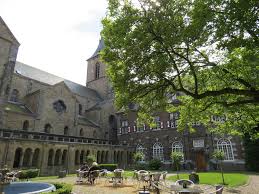 At this year’s annual conference of the International Association for the Study of Dreams
At this year’s annual conference of the International Association for the Study of Dreams  Psychologists from Sigmund Freud onwards have usually treated dreams as purely egotistical and self-centered, with no relevance outside the personal wishes of the dreamer. Every four years I try to prove that assumption wrong.
Psychologists from Sigmund Freud onwards have usually treated dreams as purely egotistical and self-centered, with no relevance outside the personal wishes of the dreamer. Every four years I try to prove that assumption wrong.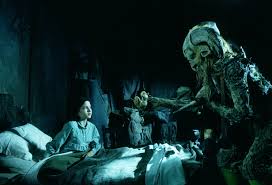 This essay is based on a presentation I gave at the
This essay is based on a presentation I gave at the  Which brings us to “Pan’s Labyrinth.” Guillermo del Toro’s 2006 film is not purely fantasy or science fiction, but rather a surrealist fairy tale folded into a wartime drama. Maybe it should be called “historical horror.”
Which brings us to “Pan’s Labyrinth.” Guillermo del Toro’s 2006 film is not purely fantasy or science fiction, but rather a surrealist fairy tale folded into a wartime drama. Maybe it should be called “historical horror.”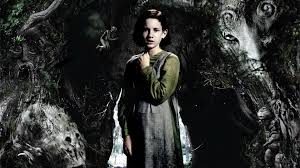 The fantasy sequences with Ofelia have some striking similarities with the typical content patterns of lucid dreams, as mentioned earlier. Here’s how I summarized the research findings a few minutes ago:
The fantasy sequences with Ofelia have some striking similarities with the typical content patterns of lucid dreams, as mentioned earlier. Here’s how I summarized the research findings a few minutes ago: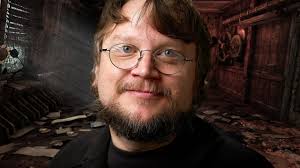 As it turns out, there is a good biographical reason for this. In interviews he gave at the time of the film’s release, del Toro described his own childhood experiences of “lucid nightmares” in which he saw the figure of the Faun stepping out from behind a dresser at midnight. He had recurrent dreams of many kinds of monsters, but the Faun made an especially horrifying impact on him. In the film del Toro aims to recreate this powerful fantasy figure who stalked his own personal nightmares.
As it turns out, there is a good biographical reason for this. In interviews he gave at the time of the film’s release, del Toro described his own childhood experiences of “lucid nightmares” in which he saw the figure of the Faun stepping out from behind a dresser at midnight. He had recurrent dreams of many kinds of monsters, but the Faun made an especially horrifying impact on him. In the film del Toro aims to recreate this powerful fantasy figure who stalked his own personal nightmares. When del Toro referred to these dreams as “lucid” he seemed to mean they had all the qualities of waking reality, and yet he knew they were dreams because of the appearance of Faun or other creatures. It’s not that he was dreaming, then realized he was awake within the dream; rather, he felt like he was awake, while also realizing he must be dreaming. Both are paths to lucidity, but the latter can be much more frightening and existentially unsettling.
When del Toro referred to these dreams as “lucid” he seemed to mean they had all the qualities of waking reality, and yet he knew they were dreams because of the appearance of Faun or other creatures. It’s not that he was dreaming, then realized he was awake within the dream; rather, he felt like he was awake, while also realizing he must be dreaming. Both are paths to lucidity, but the latter can be much more frightening and existentially unsettling.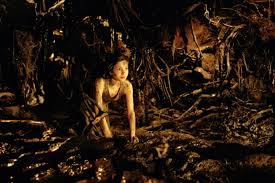 This helps to explain at least some of the uncanny impact of “Pan’s Labyrinth.” Guillermo del Toro knows from deep personal experience the feelings of dread and terror associated with the darker path into lucidity. He knows that if you are already dreaming and then become self-aware, your conscious self feels powerful and expanded. But if you realize what you thought was waking reality is actually a dream, that’s a much more threatening mode of lucidity, a lucidity of weakness, vulnerability, and deception. A lucidity of horror.
This helps to explain at least some of the uncanny impact of “Pan’s Labyrinth.” Guillermo del Toro knows from deep personal experience the feelings of dread and terror associated with the darker path into lucidity. He knows that if you are already dreaming and then become self-aware, your conscious self feels powerful and expanded. But if you realize what you thought was waking reality is actually a dream, that’s a much more threatening mode of lucidity, a lucidity of weakness, vulnerability, and deception. A lucidity of horror. In the past couple of weeks I have spoken several times with journalists about
In the past couple of weeks I have spoken several times with journalists about  It seems that every pundit on the planet has taken a shot at explaining the phenomenal rise and mercurial character of Donald Trump, currently the leading contender to become the Republican nominee for US President. A recent op-ed piece by Timothy Egan in the New York Times,
It seems that every pundit on the planet has taken a shot at explaining the phenomenal rise and mercurial character of Donald Trump, currently the leading contender to become the Republican nominee for US President. A recent op-ed piece by Timothy Egan in the New York Times,